Investigating the Influence of Medium Size and Ratio on Grinding Characteristics
Abstract
:1. Introduction
2. Discrete Element Method
2.1. Particle Motion Equations
2.2. Contact Model
2.3. Time Step
3. Research Process and Methodology
4. Results and Analysis
4.1. Verification of Simulation Test
4.2. Influence of Particle Size and Composition on Grinding Effect
4.3. Comparison of Grinding Energy Consumption
4.4. Comparison of Mill Liner Wear
5. Conclusions
6. Outlook
Author Contributions
Funding
Data Availability Statement
Conflicts of Interest
References
- Shi, F. A Review of the Applications of the JK Size-Dependent Breakage Model: Part 1: Ore and Coal Breakage Characterisation. Int. J. Miner. Process. 2016, 155, 118–129. [Google Scholar] [CrossRef]
- Akkaya, B.; Toroğlu, İ.; Bilen, M. Studying the Effect of Different Operation Parameters on the Grinding Energy Efficiency in Laboratory Stirred Mill. Adv. Powder Technol. 2020, 31, 4517–4525. [Google Scholar] [CrossRef]
- Celis, C.; Antoniou, A.; Cuisano, J.; Pillihuaman, A.; Maza, D. Experimental Characterization of Chalcopyrite Ball Mill Grinding Processes in Batch and Continuous Flow Processing Modes to Reduce Energy Consumption. J. Mater. Res. Technol. 2021, 15, 5428–5444. [Google Scholar] [CrossRef]
- Bian, X.; Wang, G.; Wang, H.; Wang, S.; Lv, W. Effect of Lifters and Mill Speed on Particle Behaviour, Torque, and Power Consumption of a Tumbling Ball Mill: Experimental Study and DEM Simulation. Miner. Eng. 2017, 105, 22–35. [Google Scholar] [CrossRef]
- Cleary, P.W. A Multiscale Method for Including Fine Particle Effects in DEM Models of Grinding Mills. Miner. Eng. 2015, 84, 88–99. [Google Scholar] [CrossRef]
- Cleary, P.W.; Morrison, R.D. Understanding Fine Ore Breakage in a Laboratory Scale Ball Mill Using DEM. Miner. Eng. 2011, 24, 352–366. [Google Scholar] [CrossRef]
- Cleary, P.W.; Owen, P. Effect of Operating Condition Changes on the Collisional Environment in a SAG Mill. Miner. Eng. 2019, 132, 297–315. [Google Scholar] [CrossRef]
- Yin, Z.; Wang, N.; Li, T.; Peng, Y. Experimental Investigation of the Impact Breakage Characteristics between Grinding Media and Iron Ore Particle in Ball Mills. Adv. Powder Technol. 2023, 34, 103982. [Google Scholar] [CrossRef]
- Qian, H.Y.; Kong, Q.G.; Zhang, B.L. The Effects of Grinding Media Shapes on the Grinding Kinetics of Cement Clinker in Ball Mill. Powder Technol. 2013, 235, 422–425. [Google Scholar] [CrossRef]
- Shi, F. Comparison of Grinding Media—Cylpebs versus Balls. Miner. Eng. 2004, 17, 1259–1268. [Google Scholar] [CrossRef]
- Li, Y.; You, Y.; Gou, D.; Yu, A.; Yang, R. A DEM Based Scale-up Model for Tumbling Ball Mills. Powder Technol. 2022, 409, 117854. [Google Scholar] [CrossRef]
- Rodríguez, B.Á.; García, G.G.; Coello-Velázquez, A.L.; Menéndez-Aguado, J.M. Product Size Distribution Function Influence on Interpolation Calculations in the Bond Ball Mill Grindability Test. Int. J. Miner. Process. 2016, 157, 16–20. [Google Scholar] [CrossRef]
- Rumpf, H. Physical Aspects of Comminution and New Formulation of a Law of Comminution. Powder Technol. 1973, 7, 145–159. [Google Scholar] [CrossRef]
- Sabah, E.; Özdemir, O.; Koltka, S. Effect of Ball Mill Grinding Parameters of Hydrated Lime Fine Grinding on Consumed Energy. Adv. Powder Technol. 2013, 24, 647–652. [Google Scholar] [CrossRef]
- Xie, C.; Ma, H.; Song, T.; Zhao, Y. DEM Investigation of SAG Mill with Spherical Grinding Media and Non-Spherical Ore Based on Polyhedron-Sphere Contact Model. Powder Technol. 2021, 386, 154–165. [Google Scholar] [CrossRef]
- Kim, K.-C.; Jiang, T.; Kim, N.-I.; Kwon, C. Effects of Ball-to-Powder Diameter Ratio and Powder Particle Shape on EDEM Simulation in a Planetary Ball Mill. J. Indian Chem. Soc. 2022, 99, 100300. [Google Scholar] [CrossRef]
- Iwasaki, T.; Yabuuchi, T.; Nakagawa, H.; Watano, S. Scale-up Methodology for Tumbling Ball Mill Based on Impact Energy of Grinding Balls Using Discrete Element Analysis. Adv. Powder Technol. 2010, 21, 623–629. [Google Scholar] [CrossRef]
- Capece, M.; Bilgili, E.; Davé, R. Insight into First-Order Breakage Kinetics Using a Particle-Scale Breakage Rate Constant. Chem. Eng. Sci. 2014, 117, 318–330. [Google Scholar] [CrossRef]
- Stoimenov, N.; Ruzic, J. Analysis of the Particle Motion during Mechanical Alloying Using EDEM Software. IFAC-PapersOnLine 2019, 52, 462–466. [Google Scholar]
- Salili, S.M.; Ataie, A.; Sadighi, Z. Effect of ball size and ball to powder ratio variation on crystallite size and formation of nanocrystalline materials in planetary ball mill. AIP Conf. Proc. 2011, 1400, 127–130. [Google Scholar]
- Engl, W.; Tachibana, M.; Colin, A.; Panizza, P. A Droplet-Based High-Throughput Tubular Platform to Extract Rate Constants of Slow Chemical Reactions. Chem. Eng. Sci. 2008, 63, 1692–1695. [Google Scholar] [CrossRef]
- Zhao, T. Introduction to Discrete Element Method. In Coupled DEM-CFD Analyses of Landslide-Induced Debris Flows; Zhao, T., Ed.; Springer: Singapore, 2017; pp. 25–45. [Google Scholar]
- Pérez Morales, I.; Roselló Valera, R.; Recarey Morfa, C.; Muniz de Farias, M. Dense Packing of General-Shaped Particles Using a Minimization Technique. Comp. Part. Mech. 2017, 4, 165–179. [Google Scholar] [CrossRef]
- Ma, S.; Chen, J. Experimental Investigation of Size Match of Grinding Media for Ball Mills. China’s Manganese Ind. 2000, 11, 27–30. [Google Scholar]
- Möller, M.F.; Peppersack, C.; Kwade, A. Milling Efficiency and Wear Behavior of Silicon Grinding Media in Autogenous Stirred Media Milling. Miner. Eng. 2024, 214, 108785. [Google Scholar] [CrossRef]
- Petrakis, E.; Komnitsas, K. Effect of Grinding Media Size on Ferronickel Slag Ball Milling Efficiency and Energy Requirements Using Kinetics and Attainable Region Approaches. Minerals 2022, 12, 184. [Google Scholar] [CrossRef]
- Javid, A.H.; Fahimifar, A.; Imani, M. Numerical Investigation on the Bearing Capacity of Two Interfering Strip Footings Resting on a Rock Mass. Comput. Geotech. 2015, 69, 514–528. [Google Scholar] [CrossRef]
- Zhang, X.R.; Zhu, Y.G.; Zheng, G.B.; Han, L.; McFadzean, B.; Qian, Z.B.; Piao, Y.C.; O’Connor, C. An Investigation into the Selective Separation and Adsorption Mechanism of a Macromolecular Depressant in the Galena-Chalcopyrite System. Miner. Eng. 2019, 134, 291–299. [Google Scholar] [CrossRef]
- Barbian, N.; Hadler, K.; Cilliers, J.J. The Froth Stability Column: Measuring Froth Stability at an Industrial Scale. Miner. Eng. 2006, 19, 713–718. [Google Scholar] [CrossRef]
- Mishra, B.K. A Review of Computer Simulation of Tumbling Mills by the Discrete Element Method: Part I—Contact Mechanics. Int. J. Miner. Process. 2003, 71, 73–93. [Google Scholar] [CrossRef]
- Rabieh, A.; Albijanic, B.; Eksteen, J.J. A Review of the Effects of Grinding Media and Chemical Conditions on the Flotation of Pyrite in Refractory Gold Operations. Miner. Eng. 2016, 94, 21–28. [Google Scholar] [CrossRef]
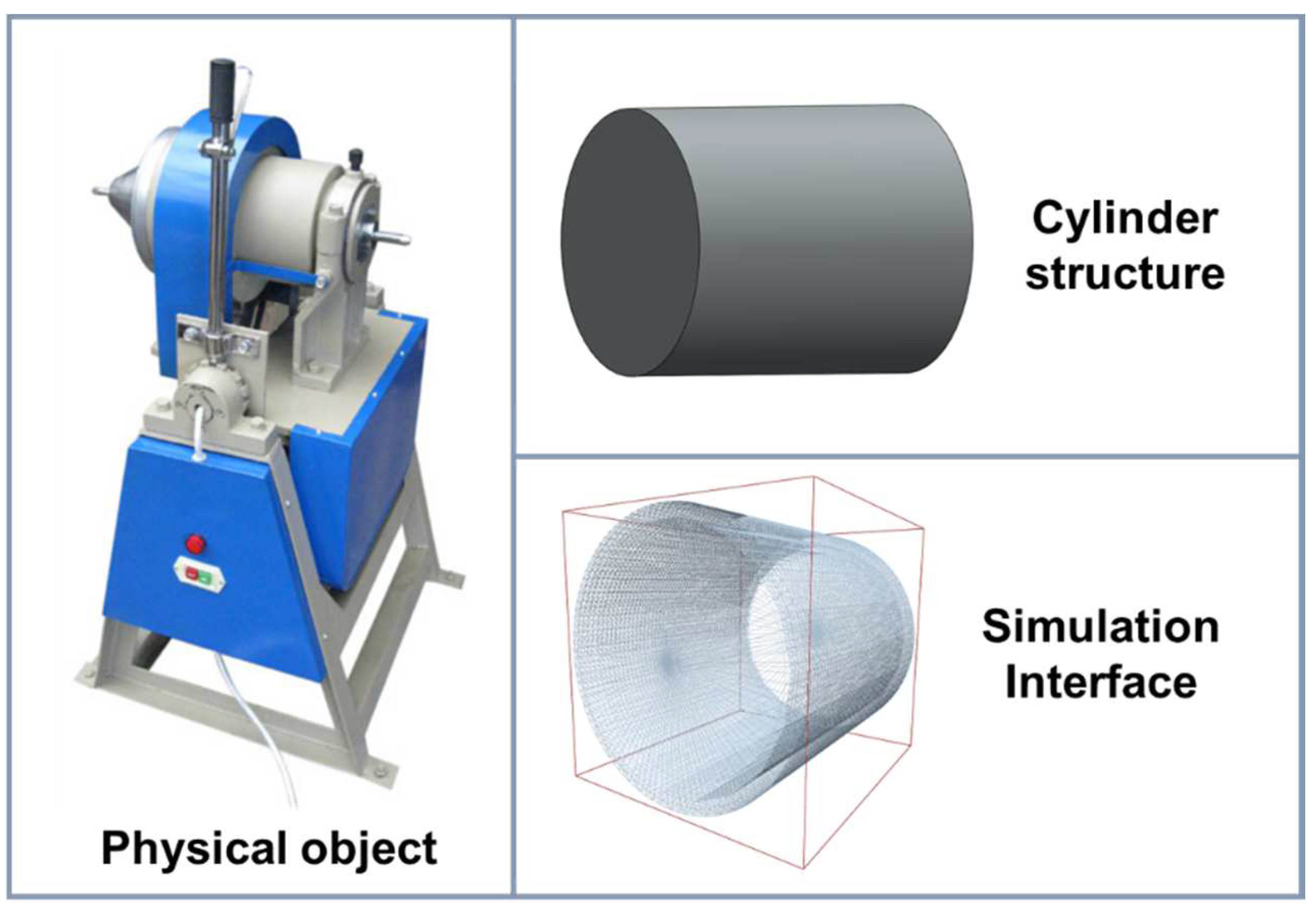

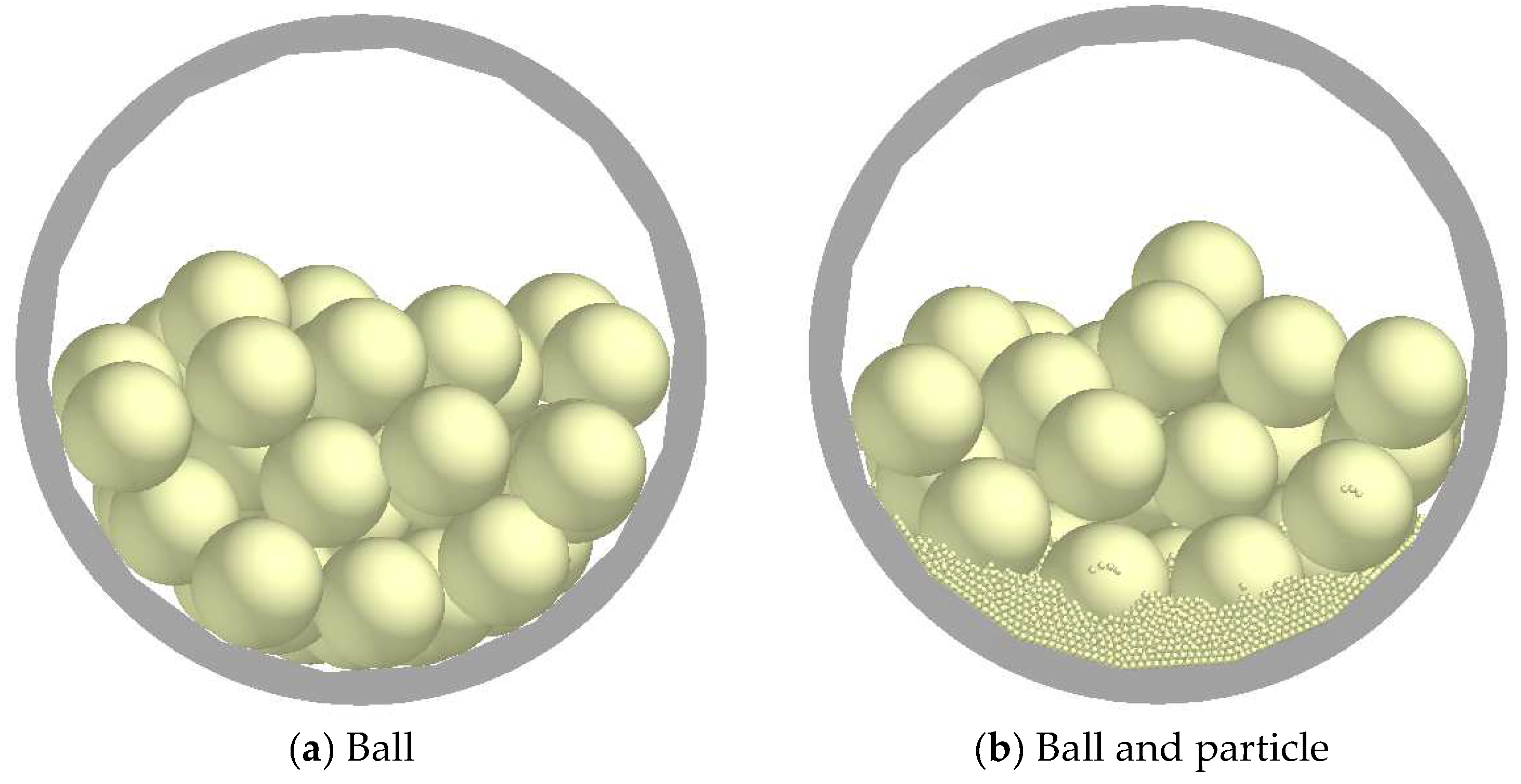




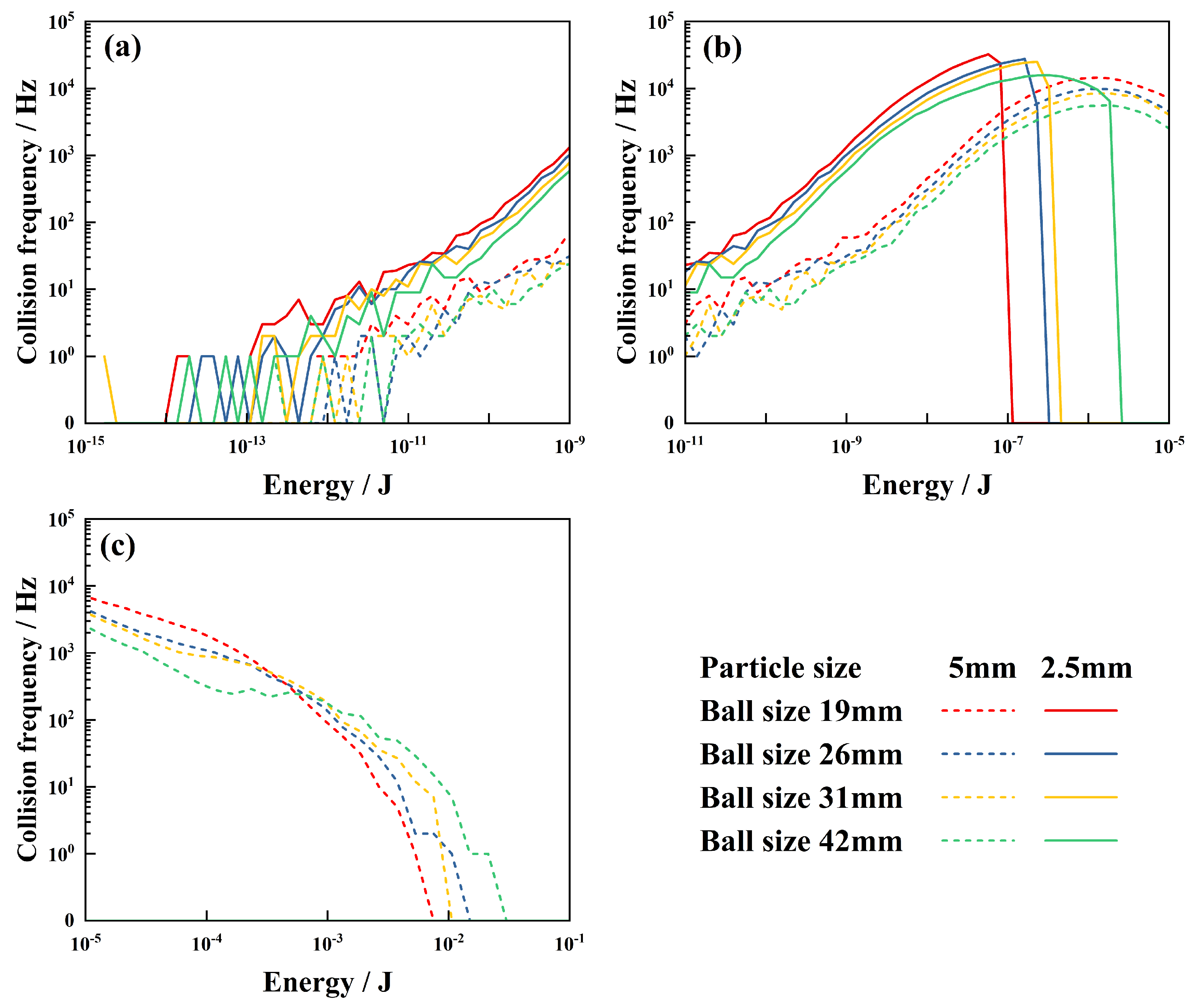


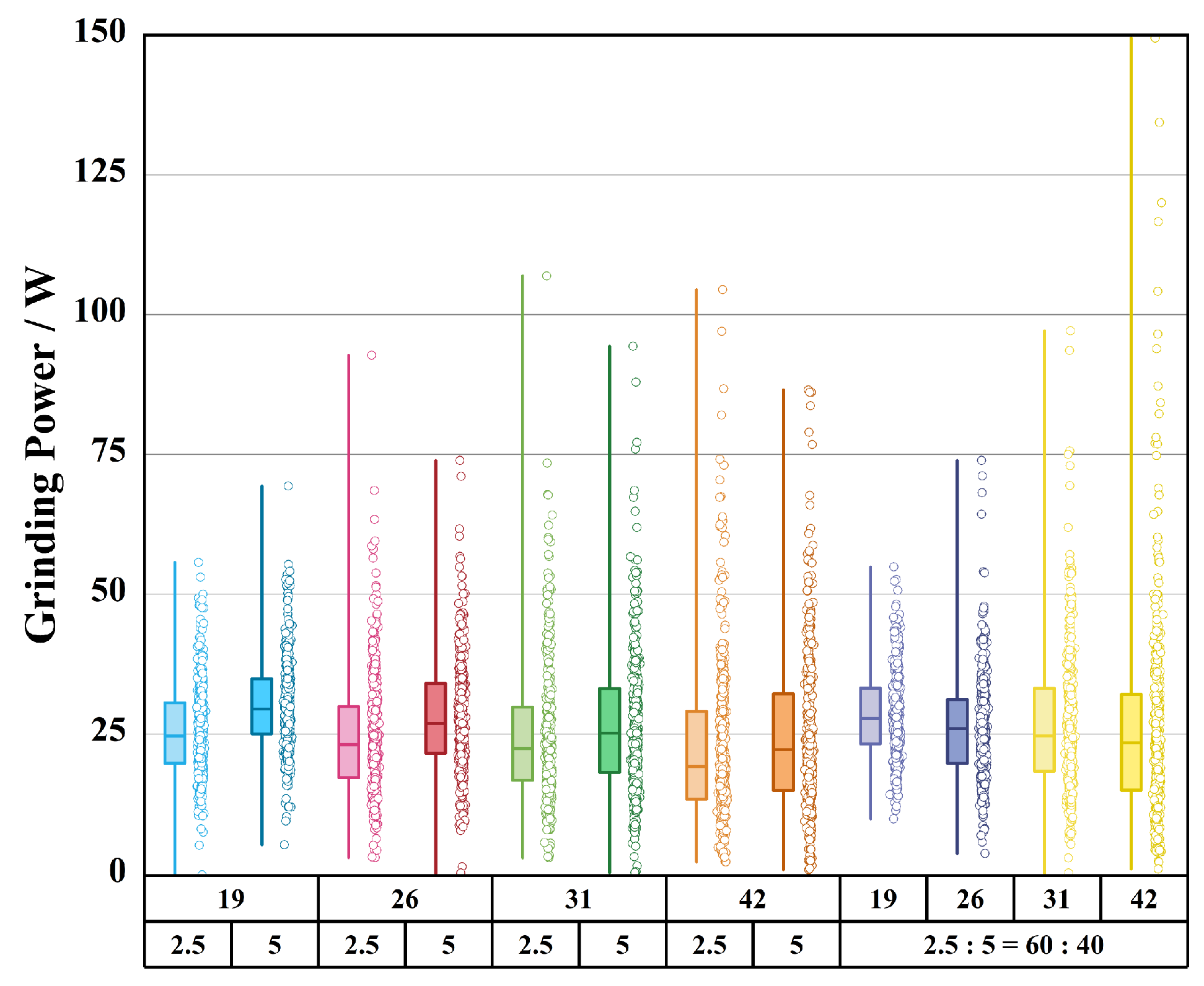
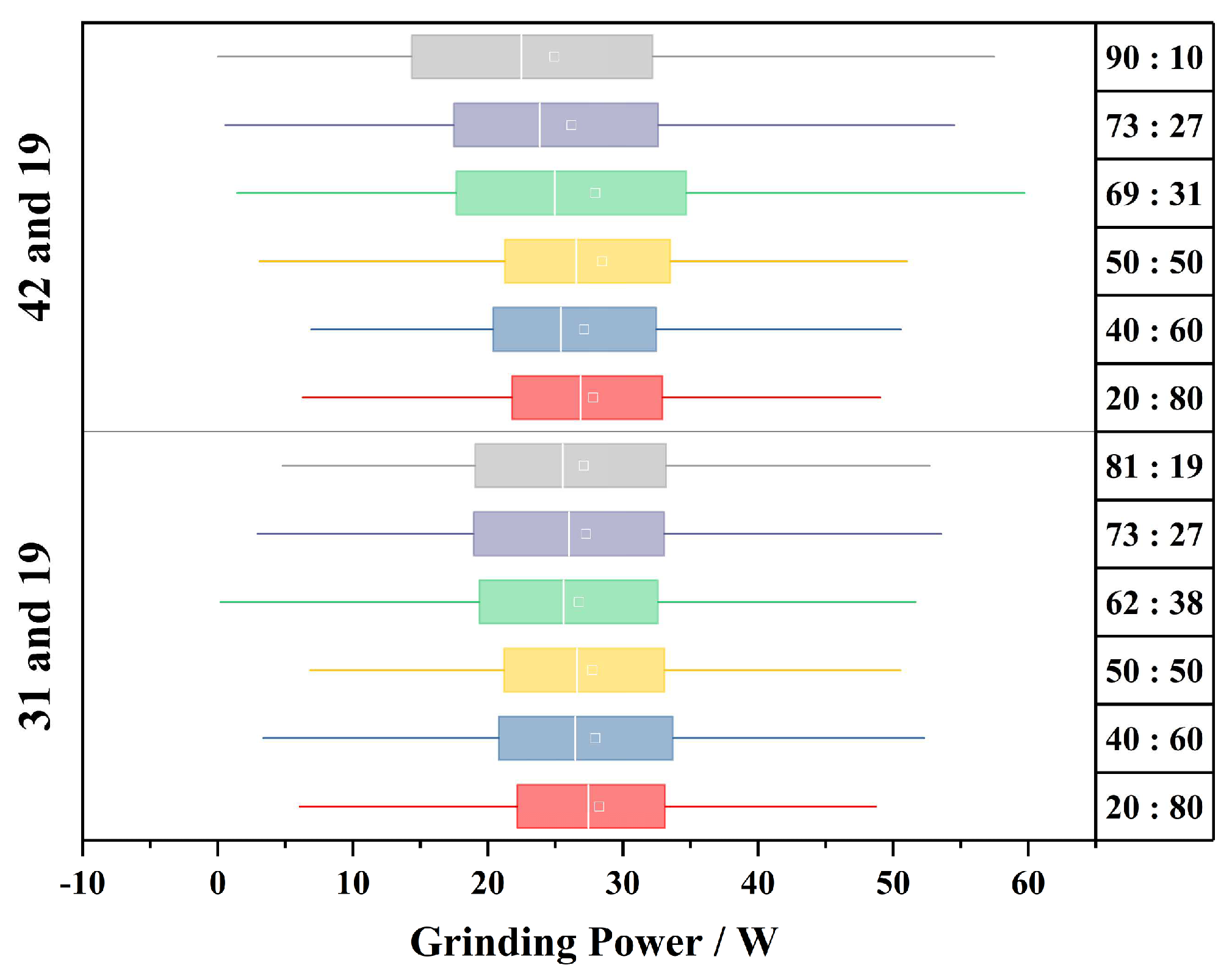


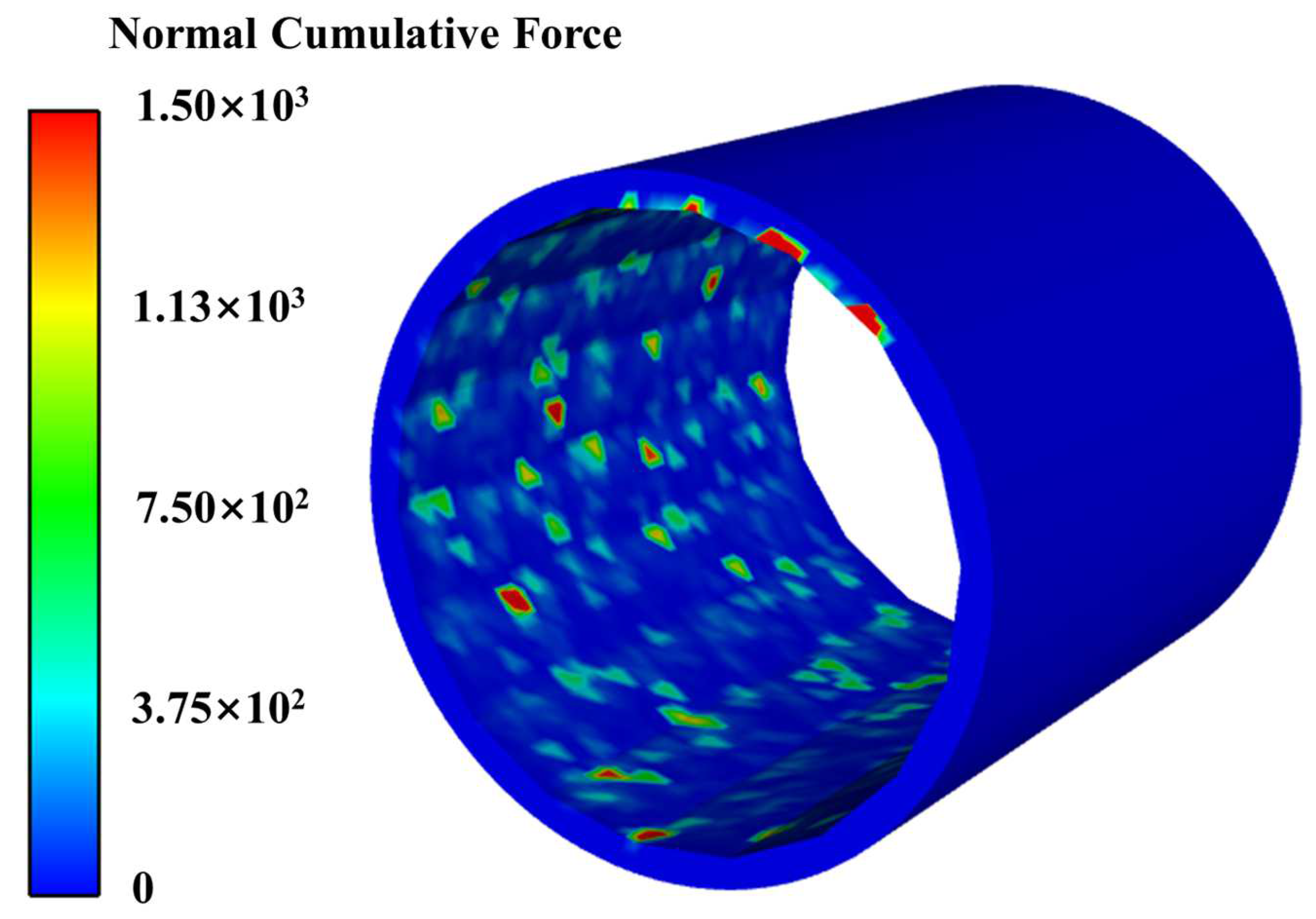
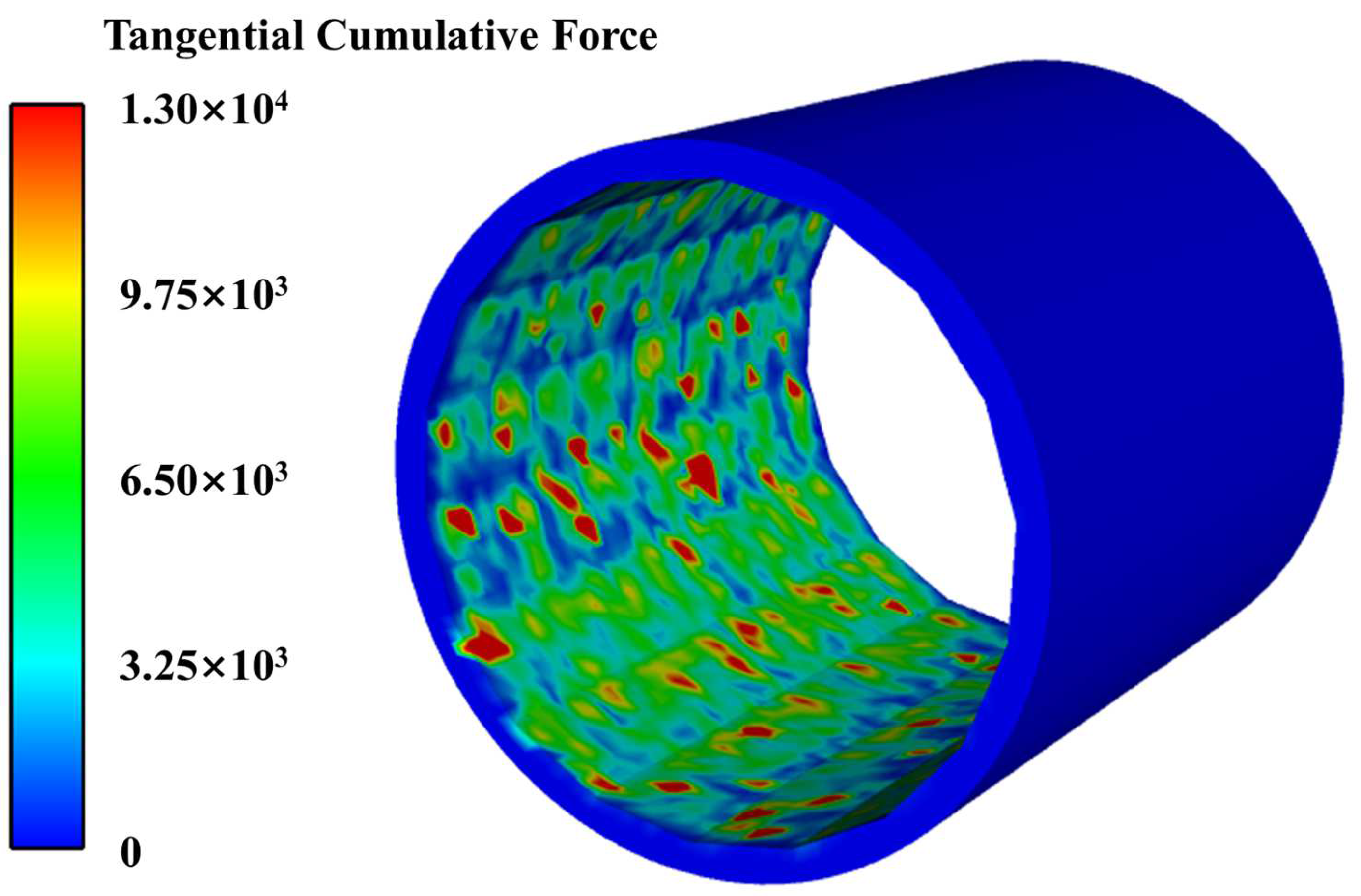
| Equation | N1/N2 | 31 and 19 mm | 42 and 19 mm |
|---|---|---|---|
| Particle size-related method | 40:60 | 40:60 | |
| Equal quality method | 50:50 | 50:50 | |
| Equal surface area method | 62:38 | 69:31 | |
| Mass–surface area method | 73:27 | 73:27 | |
| Equal number method | 81:19 | 90:10 | |
| Fixed ratio | - | 20:80 | 20:80 |
| Parameters | Values | |
|---|---|---|
| Mineral density (kg/m3) | 2300 | |
| Steel density (kg/m3) | 7850 | |
| Mineral Poisson’s ratio | 0.25 | |
| Steel Poisson’s ratio | 0.3 | |
| Mineral shear modulus | 7.55 × 107 | |
| Steel shear modulus | 7.80 × 108 | |
| Coefficient of Restitution | Media–Media | 0.5 |
| Media–Minerals | 0.4 | |
| Minerals–Minerals | 0.25 | |
| Coefficient of Static Friction | Media–Media | 0.5 |
| Media–Minerals | 0.6 | |
| Minerals–Minerals | 0.8 | |
| Coefficient of Rolling Friction | Media–Media | 0.01 |
| Media–Minerals | 0.02 | |
| Minerals–Minerals | 0.05 |
| Particle/mm | Ball | 19 | 26 | 31 | 42 | 19 | 26 | 31 | 42 | 19 | 26 | 31 | 42 |
| Mineral | 2.5 | 5 | 2.5:5 = 60:40 | ||||||||||
| Collision Energy loss/Jm | B-B | 17.0 | 13.8 | 13.2 | 11.5 | 19.6 | 17.5 | 15.7 | 13.0 | 17.9 | 15.3 | 13.9 | 12.2 |
| B-P | 3.2 | 3.2 | 3.1 | 2.9 | 3.7 | 3.0 | 2.8 | 3.2 | 3.7 | 3.4 | 3.3 | 3.1 | |
| P-P | 1.2 | 1.5 | 1.7 | 1.9 | 0.8 | 1.0 | 1.0 | 1.2 | 1.1 | 1.5 | 1.7 | 1.5 | |
| Particle/mm | Ball | 31 and 19 | 42 and 19 | ||||||||||
| Ratio | 20 80 | 40 60 | 50 50 | 62 38 | 73 27 | 81 19 | 20 80 | 40 60 | 50 50 | 69 31 | 73 27 | 90 10 | |
| Mineral | 2.5:5 = 60:40 | ||||||||||||
| Collision Energy loss/Jm | B-B | 17.0 | 16.2 | 15.9 | 15.7 | 15.0 | 14.1 | 17.2 | 15.9 | 15.6 | 13.8 | 13.6 | 13.5 |
| B-P | 3.5 | 3.5 | 3.5 | 3.6 | 3.7 | 3.3 | 3.8 | 3.8 | 3.7 | 3.8 | 3.9 | 3.6 | |
| P-P | 1.3 | 1.4 | 1.6 | 1.5 | 1.6 | 1.5 | 1.4 | 1.5 | 1.5 | 1.9 | 1.9 | 1.7 | |
| Breakage Rates/s−1 | −2.5 mm | 0.256 | 0.266 | 0.271 | 0.272 | 0.274 | 0.276 | 0.256 | 0.269 | 0.270 | 0.276 | 0.277 | 0.277 |
Disclaimer/Publisher’s Note: The statements, opinions and data contained in all publications are solely those of the individual author(s) and contributor(s) and not of MDPI and/or the editor(s). MDPI and/or the editor(s) disclaim responsibility for any injury to people or property resulting from any ideas, methods, instructions or products referred to in the content. |
© 2024 by the authors. Licensee MDPI, Basel, Switzerland. This article is an open access article distributed under the terms and conditions of the Creative Commons Attribution (CC BY) license (https://creativecommons.org/licenses/by/4.0/).
Share and Cite
Fang, X.; Wu, C.; Liao, N.; Zhong, J.; Duan, X.; Zhu, S.; Liu, A.; Xiao, K. Investigating the Influence of Medium Size and Ratio on Grinding Characteristics. Minerals 2024, 14, 875. https://doi.org/10.3390/min14090875
Fang X, Wu C, Liao N, Zhong J, Duan X, Zhu S, Liu A, Xiao K. Investigating the Influence of Medium Size and Ratio on Grinding Characteristics. Minerals. 2024; 14(9):875. https://doi.org/10.3390/min14090875
Chicago/Turabian StyleFang, Xin, Caibin Wu, Ningning Liao, Jiuxiang Zhong, Xuqian Duan, Shenglin Zhu, Aijun Liu, and Ke Xiao. 2024. "Investigating the Influence of Medium Size and Ratio on Grinding Characteristics" Minerals 14, no. 9: 875. https://doi.org/10.3390/min14090875






